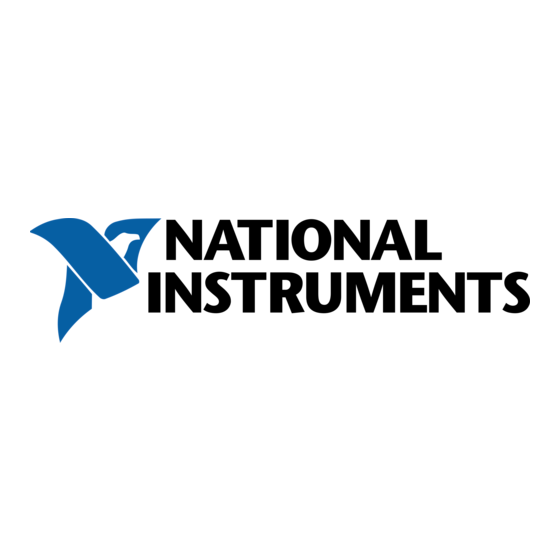Table of Contents
Advertisement
Quick Links
GETTING STARTED GUIDE
NI REM-11100
Voltage Input Module for Remote I/O
This document explains how to connect to the REM-11100.
Note
The guidelines in this document are specific to the REM-11100. The other
components in the system might not meet the same safety ratings. Refer to the
documentation for each component in the system to determine the safety and EMC
ratings for the entire system.
Caution
document. Product misuse can result in a hazard. You can compromise the safety
protection built into the product if the product is damaged in any way. If the product
is damaged, return it to NI for repair.
Do not operate the REM-11100 in a manner not specified in this
Advertisement
Table of Contents

Subscribe to Our Youtube Channel
Summary of Contents for National Instruments NI REM-11100
- Page 1 GETTING STARTED GUIDE NI REM-11100 Voltage Input Module for Remote I/O This document explains how to connect to the REM-11100. Note The guidelines in this document are specific to the REM-11100. The other components in the system might not meet the same safety ratings. Refer to the documentation for each component in the system to determine the safety and EMC ratings for the entire system.
-
Page 2: Isolation Withstand Voltages
Isolation Withstand Voltages Test section Test voltage 5 V communications power (logic), 24 V supply (I/O) 500 VAC, 50 Hz, 1 min. 5 V supply (logic) / analog inputs 500 VAC, 50 Hz, 1 min. 5 V supply (logic) / functional earth ground 500 VAC, 50 Hz, 1 min. -
Page 3: Verifying The Kit Contents
Do not install a device if it appears damaged in any way. Unpack any other items and documentation from the kit. Store the device in the antistatic package when the device is not in use. REM-11100 Getting Started Guide | © National Instruments | 3... -
Page 4: Installing Bus Connectors
Installing the REM-11100 Figure 2. Structure of the REM-11100 1. Bus connector 4. Supply voltage connector 2. REM-11100 5. Spring-terminal block 3. Module function label 6. LED indicators Table 1. Module Function Labels Label Color Module Function Blue Digital input Digital output Green Analog input, thermocouple... -
Page 5: Installing The Module
Repeat Steps 2 and 3 for additional bus connectors. Installing the Module What to Use • REM-11100 • Mounted bus connector What to Do Complete the following steps to install the REM-11100 on the DIN rail. REM-11100 Getting Started Guide | © National Instruments | 5... -
Page 6: Installing Spring-Terminal Blocks
Note When using the Remote I/O Shield Set, install the shield rail supports before mounting the module. Align the REM-11100 over the appropriate bus connector. Note Verify that the bus connector socket aligns with the socket on the underside of the module. Press the REM-11100 directly onto the bus connector and DIN rail until it clicks into place. - Page 7 Negative voltage connection for channel 0 to 3 20 to 23 0 to U 24 V sensor supply for channel 0 to 3 30 to 33 Reference potential of sensor supply REM-11100 Getting Started Guide | © National Instruments | 7...
- Page 8 Figure 3. REM-11100 LEDs Table 3. LED Indicators LED Color LED Pattern Indication Solid The REM-11100 is ready for operation. Green Flashing Data is invalid or unavailable. The REM-11100 cannot communicate with the Green/Yellow Flashing connected devices. The REM-11100 did not detect a valid cycle after power- Solid Yellow Flashing...
-
Page 9: Connection Guidelines
Connect the cable shield to functional earth ground immediately after the cables enter the control cabinet. • Connect the cable shield to a shield bus if you are not using a closed control cabinet. REM-11100 Getting Started Guide | © National Instruments | 9... -
Page 10: Removing Components
• NI recommends using the NI Remote I/O Shield Set for optimal shield connection. • Make sure that devices you connect to the REM-11100 are compatible with the module specifications. • Push the wire into the terminal when using a solid wire or a stranded wire with a ferrule. •... -
Page 11: Removing Bus Connectors
If you want to remove a bus connector in the middle of the system, you must remove any modules or bus connectors following the desired connector or slide them along the DIN rail at least 15.0 mm (0.60 in.). REM-11100 Getting Started Guide | © National Instruments | 11... -
Page 12: Where To Go Next
Where to Go Next HARDWARE SOFTWARE APPLICATION Setting Up EtherCAT NI-Industrial Communication Remote I/O Vendor on NI Programmable for EtherCAT Help Configuration Guide Automation Controllers ni.com/manuals ni.com/info ecat16help ni.com/info ecatsetup Remote I/O Sample Learn LabVIEW Basics Projects ni.com/gettingstarted LabVIEW Create Project EtherCAT Driver Support Remote I/O Examples ni.com/info... - Page 13 United States, visit the Worldwide Offices section of ni.com/ niglobal to access the branch office websites, which provide up-to-date contact information, support phone numbers, email addresses, and current events. REM-11100 Getting Started Guide | © National Instruments | 13...
- Page 14 CONTAINED HEREIN AND SHALL NOT BE LIABLE FOR ANY ERRORS. U.S. Government Customers: The data contained in this manual was developed at private expense and is subject to the applicable limited rights and restricted data rights as set forth in FAR 52.227-14, DFAR 252.227-7014, and DFAR 252.227-7015. © 2016 National Instruments. All rights reserved. 376557A-01 Oct16...








Need help?
Do you have a question about the NI REM-11100 and is the answer not in the manual?
Questions and answers